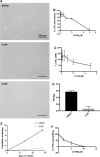Generation of a novel model of primary human cell senescence through Tenovin-6 mediated inhibition of sirtuins
- PMID: 30666570
- PMCID: PMC6535423
- DOI: 10.1007/s10522-018-09792-0
Generation of a novel model of primary human cell senescence through Tenovin-6 mediated inhibition of sirtuins
Abstract
Cell senescence, a state of cell cycle arrest and altered metabolism with enhanced pro-inflammatory secretion, underlies at least some aspects of organismal ageing. The sirtuin family of deacetylases has been implicated in preventing premature ageing; sirtuin overexpression or resveratrol-mediated activation of sirtuins increase longevity. Here we show that sirtuin inhibition by short-term, low-dose treatment with the experimental anti-cancer agent Tenovin-6 (TnV6) induces cellular senescence in primary human fibroblasts. Treated cells cease proliferation and arrest in G1 of the cell cycle, with elevated p21 levels, DNA damage foci, high mitochondrial and lysosomal load and increased senescence-associated β galactosidase activity, together with actin stress fibres and secretion of IL-6 (indicative of SASP upregulation). Consistent with a histone deacetylation role of SIRT1, we find nuclear enlargement, possibly resulting from chromatin decompaction on sirtuin inhibition. These findings highlight TnV6 as a drug that may be useful in clinical settings where acute induction of cell senescence would be beneficial, but also provide the caveat that even supposedly non-genotoxic anticancer drugs can have unexpected and efficacy-limiting impacts on non-transformed cells.
Keywords: Ageing; HDAC/KDAC; Longevity; SASP; Senescence; Sirtuin; Tenovin-6; p21.
Conflict of interest statement
The authors declare no conflicting financial interests.
Figures








Similar articles
-
Resveratrol Induced Premature Senescence Is Associated with DNA Damage Mediated SIRT1 and SIRT2 Down-Regulation.PLoS One. 2015 Apr 29;10(4):e0124837. doi: 10.1371/journal.pone.0124837. eCollection 2015. PLoS One. 2015. PMID: 25924011 Free PMC article.
-
Tenovin-D3, a novel small-molecule inhibitor of sirtuin SirT2, increases p21 (CDKN1A) expression in a p53-independent manner.Mol Cancer Ther. 2013 Apr;12(4):352-60. doi: 10.1158/1535-7163.MCT-12-0900. Epub 2013 Jan 15. Mol Cancer Ther. 2013. PMID: 23322738
-
Induction of Nuclear Enlargement and Senescence by Sirtuin Inhibitors in Glioblastoma Cells.Immune Netw. 2016 Jun;16(3):183-8. doi: 10.4110/in.2016.16.3.183. Epub 2016 Jun 17. Immune Netw. 2016. PMID: 27340387 Free PMC article.
-
Combating cellular senescence by sirtuins: Implications for atherosclerosis.Biochim Biophys Acta Mol Basis Dis. 2019 Jul 1;1865(7):1822-1830. doi: 10.1016/j.bbadis.2018.06.011. Epub 2018 Jun 23. Biochim Biophys Acta Mol Basis Dis. 2019. PMID: 29944946 Review.
-
Stilbene Compounds Inhibit Tumor Growth by the Induction of Cellular Senescence and the Inhibition of Telomerase Activity.Int J Mol Sci. 2019 Jun 2;20(11):2716. doi: 10.3390/ijms20112716. Int J Mol Sci. 2019. PMID: 31159515 Free PMC article. Review.
Cited by
-
Metabolic pathways in immune senescence and inflammaging: Novel therapeutic strategy for chronic inflammatory lung diseases. An EAACI position paper from the Task Force for Immunopharmacology.Allergy. 2024 May;79(5):1089-1122. doi: 10.1111/all.15977. Epub 2023 Dec 18. Allergy. 2024. PMID: 38108546 Free PMC article. Review.
-
Intercellular Transfer of Mitochondria between Senescent Cells through Cytoskeleton-Supported Intercellular Bridges Requires mTOR and CDC42 Signalling.Oxid Med Cell Longev. 2021 Jul 31;2021:6697861. doi: 10.1155/2021/6697861. eCollection 2021. Oxid Med Cell Longev. 2021. PMID: 34373767 Free PMC article.
References
Publication types
MeSH terms
Substances
Grants and funding
LinkOut - more resources
Full Text Sources

